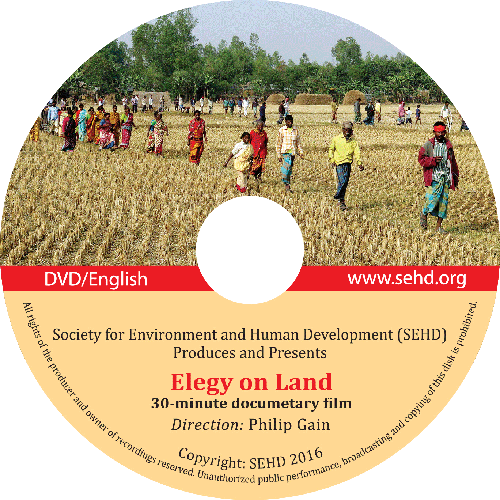30-minute documentary film on soil and blood in Northwestern districts of Bangladesh
When politics, religion andpoverty collide in the struggle for land, the results can be catastrophic. Such is the nature of the stories described in Elegy on Land or Matir Maya, a 30-minute documentary film produced by Society for Environment and Human Development. The film gives a vivid description of the struggles of different ethnic communities of the Northwestern districts of Bangladesh to retain the ownershipto their lands.
Direction and screenplay: Philip Gain | Produced by: Society for Environment and Human Development | Available in English and Bangla
The film takes us through the plains of Rajshahi to Dinajpur to Gaibandha and tells the stories of five cases of land dispossession and the subsequent quest for justice. Fear of murder, pillage and destruction are ever-present throughout this documentary. Its ultimate message is simple: urgent action must be taken to protect the land rights of Bangladesh’s impoverished, deprived and excluded ethnic communities.
The documentary starts off with the story of Sicilia Hasda of Pachondor village in Rajshahi, a Mahle woman whose family lost everything when their house was demolished with the help of the local police following an eviction decree based on false claims of ownership by Bangalees from a neighboring village. Her emotional recounting of her tale poignantly illustrates the current situation and what is at stake for many in Bangladesh’s ethnic communities.
In Nawabganj, Dinajpur, we are introduced to Robi Soren, a Santal from Kachua village, whose father and grandfather were both killed by land grabbers and saw no justice for their crimes. His story illustrates the cycle of violence, poverty and fear that affects generation after generation of ethnic minority communities amid the lawlessness that is endemic of Bangladesh’s convoluted land tenure system.
In Chapainawabganj, Bichitra Tirki, an Oraon woman recounts her struggle to regain control of her husband’s rightful property after his death and the terror and constant attacks she had to endure as a result.
In Chirakuta village of Dinajpur, clashes between the Santals and Bangalees over control of land have led to bloodshed and heartbreak for both communities. In the documentary, we are introduced to individuals from both sides of the clash as they recount what they have lost and the pain that they have had to endure as a result of the conflicts. Their stories poignantly illustrate the true human cost of Bangladesh’s hunger and obsession for land.
In Gobindaganj upazila of Gaibandha, we are introduced to a local adivasi land rights movement called, Shahebganj Bagda Farm Bhumi Uddhar Shongram Committee (Shahebganj Bagda Farm Land Reclamation Struggle Committee) and the activists that are fighting to regain control of the land they lost when the Pakistan government acquired it to establish the now-defunct Rangpur Sugar Mill in 1955.
These stories cover a wide range of ethnic groups and geographies but the underlying themes remain the same. A lack of legal protection coupled with the passivity of the state makes minority groups vulnerable to violence and predatory land grabbers and creates a cycle of landlessness and poverty, which has socioeconomically crippled many of these communities.
The documentary takes us through an emotional journey. The ending, much like the subject matter, remains open and unresolved. The ultimate fate of the characters we have met in the documentary remains unknown. In these stories, there are likely no happy endings.

